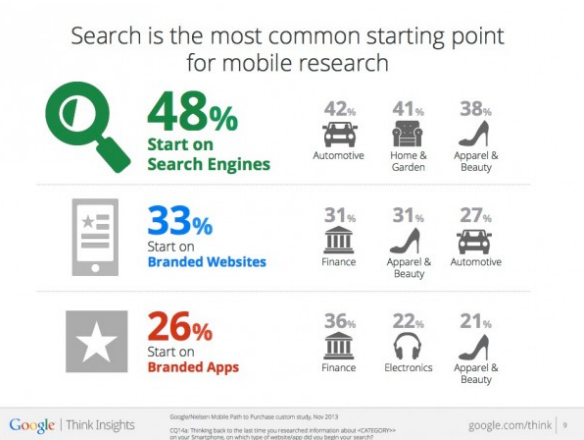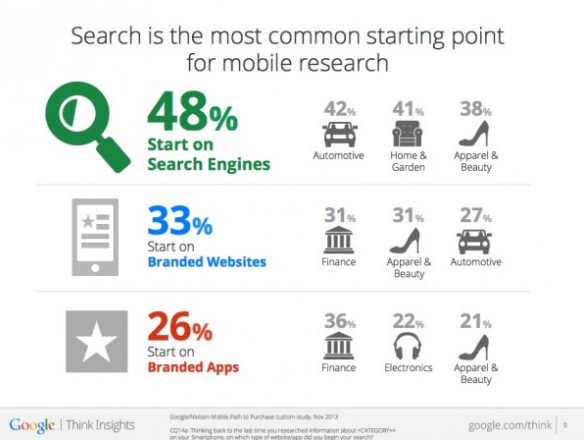As we approach the midpoint of this year, it’s interesting to note where things have been moving in the B2B marketing space. The year opened up with a lot of fanfare and forward-looking posts, with marketers vowing to spend more time on creating meaningful content and turning their attention towards consistency in their promotion and advertising. The question is, how has that all held up? And further, what are the areas that B2B marketers need to devote a renewed attention and focus to as this year continues to progress? We’ve done a quick roundup of some of the meaningful trends to turn your attention towards – from the shifting of the market to the ever-present need for better documentation.
 A Q4 report from 2013 showed that nearly 27% of all Ecommerce traffic stems from tablets and smartphones, up nearly 10% from the same quarter a year earlier.
A Q4 report from 2013 showed that nearly 27% of all Ecommerce traffic stems from tablets and smartphones, up nearly 10% from the same quarter a year earlier.
 And recent data has also shown that conversion rates from mobile are as high as 3.06% in the U.S., with add-to-cart rates as high as 8.84%.
And recent data has also shown that conversion rates from mobile are as high as 3.06% in the U.S., with add-to-cart rates as high as 8.84%.
 The takeaway here is pretty obvious: Mobile-friendliness is mission-critical at this stage for B2B businesses. If you’re not mobile-ready by now, it’s time to make this a top priority. It’s not just kids on their smartphones – a study by the Financial Times and Doremus, New York, revealed 49% of global business executives (based on a survey of 400) said that tablets were replacing their laptops. But there’s a second takeaway – Mobile ad spending is no longer a novelty or joke. The platform topped $7.3 billion in 2013 (a 77.3% increase over the previous year!) and is set to surpass $20.7 billion by 2017. This is an area your business ought to be giving a more serious look.
The takeaway here is pretty obvious: Mobile-friendliness is mission-critical at this stage for B2B businesses. If you’re not mobile-ready by now, it’s time to make this a top priority. It’s not just kids on their smartphones – a study by the Financial Times and Doremus, New York, revealed 49% of global business executives (based on a survey of 400) said that tablets were replacing their laptops. But there’s a second takeaway – Mobile ad spending is no longer a novelty or joke. The platform topped $7.3 billion in 2013 (a 77.3% increase over the previous year!) and is set to surpass $20.7 billion by 2017. This is an area your business ought to be giving a more serious look.
1. Millenials are Changing Buying Behavior
According to Acquity Group, Millenials (approximately 25 – 34) are 131% more likely to buy online than their Gen X and Baby Boomer counterparts – and now, those millenials are holding buying and leadership positions that affect B2B relationships. In fact, Corporate Executive Board found that 77% of B2B buyers didn’t even talk to a salesperson until they had conducted extensive personal research – online. And if you think they’re making rinky-dink little purchases, think again – the research from Acquity Group showed that 13% of B2B buyers with budgets of at least $500 million were making their purchases online. This leaves B2B firms with a few takeaways:- Online purchasing is only going to increase. If you’re still spending a ton of budget on offline initiatives, now is a good time to evaluate the effectiveness of all those cold calls, billboards and adverts – and determining whether or not you could be earning more with online initiatives.
- You need to plug those salespeople into the online process. Those sales people at the very end of the funnel can bring a myriad of insights that can make your online efforts more effective– the questions people are still asking, the concerns people have and the demographics and psychographics that can inform your targeted personas.
- You need to take another look at your conversion funnel. If you haven’t taken a deliberate look at the metrics surrounding leads, sales and the chokepoints of your conversion funnel, now is the time to look at your content and your online marketing assets to see where you’re missing out on this ever-emerging and lucrative market.
2. Content Marketing Remains Popular.. & Poorly Managed
You can hardly be surprised by this one – but of 2013 was the year of content marketing, 2014 is the year that content marketing grows up a little bit. In a survey by Adobe and Econsultancy, B2B marketers saw content marketing as the most significant opportunity for their business (24%), surpassing even mobile, customer experience tailoring and multi- channel campaign management. According to the Content Marketing Institute, 93% of B2B companies are using content marketing as a tactic, allocating up to 30% of their marketing spend toward these endeavors. It makes sense – the stats show that companies who blog regularly enjoy a full 67% more leads than their non-blogging counterparts (and that’s just one type of content). But what’s a little more curious is how they are (or aren’t) managing the content process. For starters, a mere 42% of B2B marketers are happy with the potency of their content marketing work. That could be because just 58% of large B2B companies have appointed someone to be in charge of their content marketing strategy. Oddly, smaller companies lead the way (78% have someone in Most concerning, though, is that a mere 44% of B2B companies have documented their strategy – a problem because it means that there are no documented benchmarks, processes or even goals to be working towards. For something earning a 1/3rd Takeaway: Yes, content marketing is still very much in vogue (and effective, too!), but if you’re not documenting your strategy or you haven’t put someone in charge, this is the time to change that3. B2B Marketers are Diversifying Their Online Involvement
In years past, B2B firms leaned heavily on a small set of tactics, putting a lot of stake in just a few initiatives. SEO was the kingpin, while online ads came a close second. Now, however, B2B marketers are stretching out and embracing multi-channel campaigns and content initiatives with a new kind of fervor – perhaps indicative of the fact that no one channel can do all of the heavy lifting anymore. According to the Content Marketing Institute, the average B2B firm uses no less than 13 different channels online. Some of the more interesting growth is on platforms B2B businesses either haven’t historically been a big part of, or didn’t leverage very well, for example:- 91% are on LinkedIn - which makes sense, since it’s a business environment
- 73% have made the move to promoting content on YouTube. This is exciting for marketers, as video seems to be a massively under-utilized marketing medium. Finally, this visual medium is getting the respect it deserves. In fact, a survey by Regalix showed that 75% of B2B marketers think video is going to be the most effective content asset in 2014.
- 55% are on Google. To be honest, even that seems high – the engagement of B2B with Google+ has been woeful, partially because their audience has yet to move on there. That said, it’s becoming a hugely important channel for search as well, with Circles, personalization and shared content all seeming to give a big of a boost to traffic and leads numbers.
- A surprising 40% are on Slideshare! This is one of those mediums B2B’s really should be more involved on – the chance to put information into a slide deck format and sum it up nicely for prospects is not one to miss.
- An even more surprising 20% are on Instagram. B2B marketing is invading channels that typically were reserved for casual audiences or seemed more suited to B2C interactions. In fact, this year, B2B marketers are proving there are no channels B2C can excel on that B2B can’t also make gains with.
4. Mobile is NOW
Mobile isn’t the future of marketing – it’s already here, and it’s having a profound impact on online Recent data from March shows that the majority of consumers are “multiscreening” – accessing sites via mobile or desktop (or both), creating a need for a consistent experience across both platforms. In a Google study, 48% of mobile consumers started on a search engine, 33% started on branded website and 26% started on a branded app – showcasing the need for presence in multiple ways.


There’s still a lot of year left!
There’s still a lot to be developed in 2014 – things like Native Advertising continue to grow in popularity, search engine penalties and updates continue to shape strategies and new challenges, like managing all of your online data, are becoming more and more of a factor (with more exciting and diverse solutions). We’ve highlighted some of the major trends out there in the market – but what do YOU see as the trend to watch for in the rest of this coming year?

